FAQ - Advanced Bathroom Queries
Can You Flush Objects Down the Toilet

As conscientious people striving for excellence in proper trash elimination, it’s essential that we tackle the widespread misunderstanding: is it acceptable to flush items down the toilet?
Let us dive into the technicalities and consequences of this action. Discover the types of objects that should never be flushed, the potential damage to your plumbing system, and the environmental impacts.
From medications to personal hygiene products, we will uncover the truth and provide responsible disposal methods for various objects.
Join us on this informative journey.
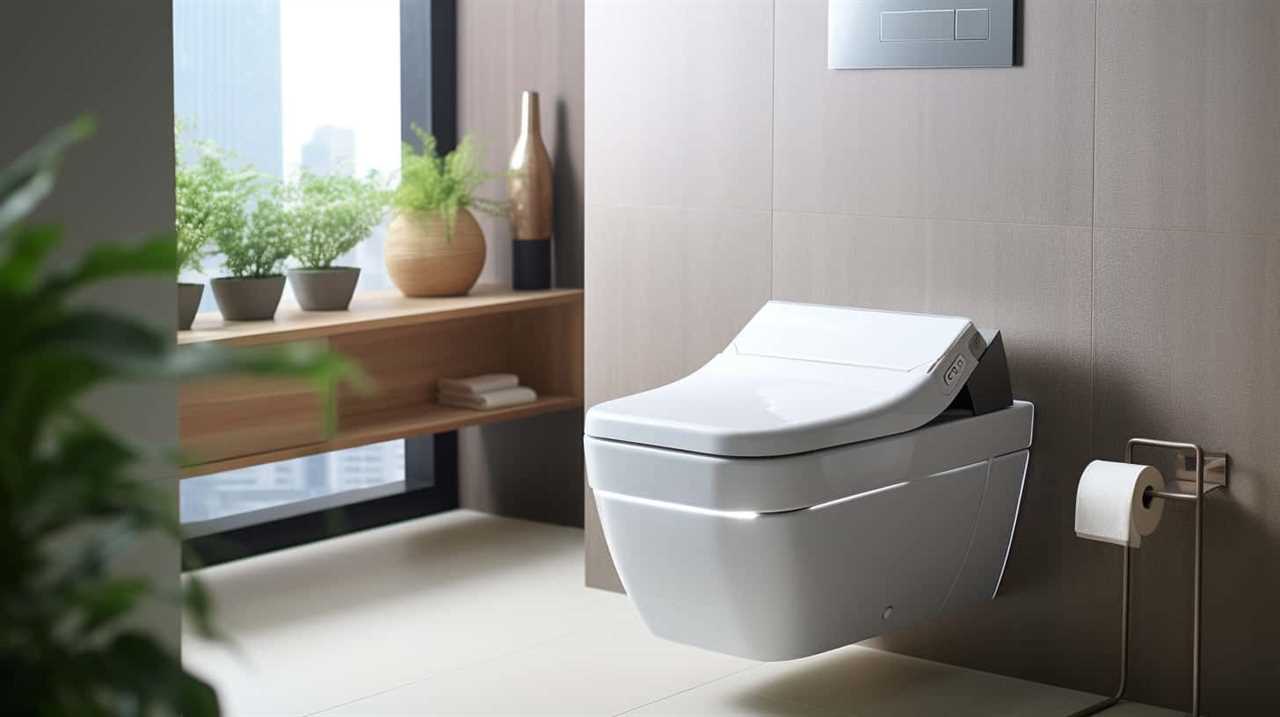
Key Takeaways
- Proper toilet waste disposal is important for maintaining plumbing system functionality and cleanliness.
- Flushing only human waste and toilet paper prevents clogs, blockages, and damage to pipes.
- Flushing objects such as sanitary products, baby wipes, and medications can lead to costly repairs and potential health hazards.
- Flushing non-biodegradable objects can harm the environment, contaminate water sources, and damage sewer systems.
The Importance of Proper Toilet Waste Disposal
The proper disposal of toilet waste is of utmost importance for maintaining the functionality and cleanliness of our plumbing systems. Water conservation and proper waste management are crucial aspects of this process.
By ensuring that only human waste and toilet paper are flushed down the toilet, we can prevent clogs and blockages in the pipes. Flushing other items such as wet wipes, sanitary products, or paper towels can lead to costly repairs and damage to the plumbing infrastructure.
Moreover, proper waste management reduces the strain on our water treatment facilities and helps conserve water resources. It’s essential to educate ourselves and others about the correct disposal methods to maintain the efficiency and longevity of our plumbing systems while also promoting water conservation and responsible waste management practices.
Common Misconceptions About Flushing Objects
Our common misconception about flushing objects down the toilet is that it’s acceptable to dispose of them in this manner. However, this belief is one of the many toilet myths and common plumbing misconceptions that need to be debunked.

Flushing objects down the toilet can have serious consequences for your plumbing system. It can lead to clogs, blockages, and even damage to your pipes. The truth is, toilets are designed to handle only human waste and toilet paper. Anything else, such as sanitary products, baby wipes, or even small objects, shouldn’t be flushed.
These items can cause blockages in your pipes or get stuck in the sewer system, leading to costly repairs and potential health hazards. It’s important to properly dispose of these items in the trash to avoid any plumbing issues.
Types of Objects That Should Never Be Flushed
Now let’s explore the objects that should never be flushed down the toilet to avoid plumbing issues and potential damage.
It’s crucial to be aware of these items to prevent costly repairs and potential health hazards.
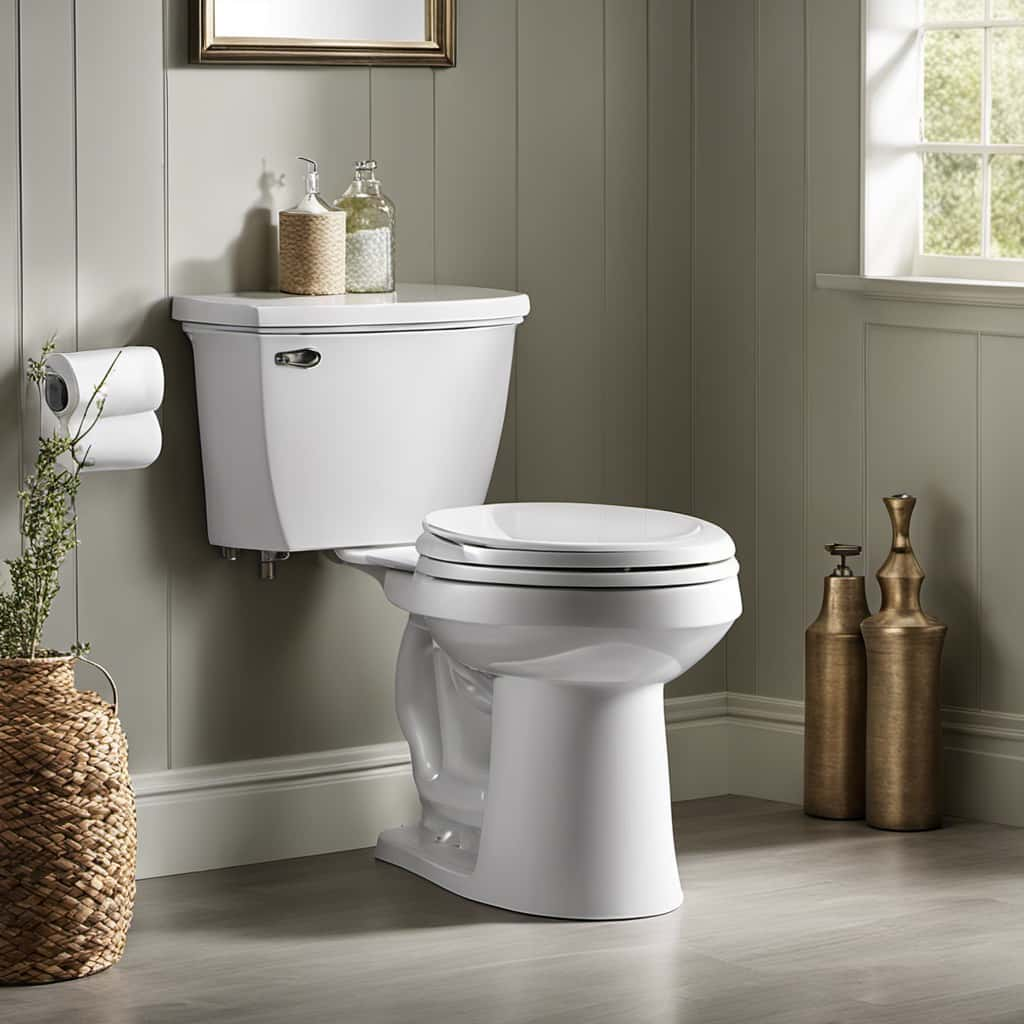
Firstly, feminine hygiene products such as tampons and sanitary pads should never be flushed. These items can easily clog the pipes and cause blockages.
Secondly, diapers and baby wipes should also be disposed of using alternative methods, as they don’t break down in water and can lead to serious plumbing problems.
Additionally, medications shouldn’t be flushed down the toilet as they can contaminate water sources and harm the environment.
Lastly, household chemicals, like paint thinner and bleach, should be disposed of safely through designated waste disposal systems.
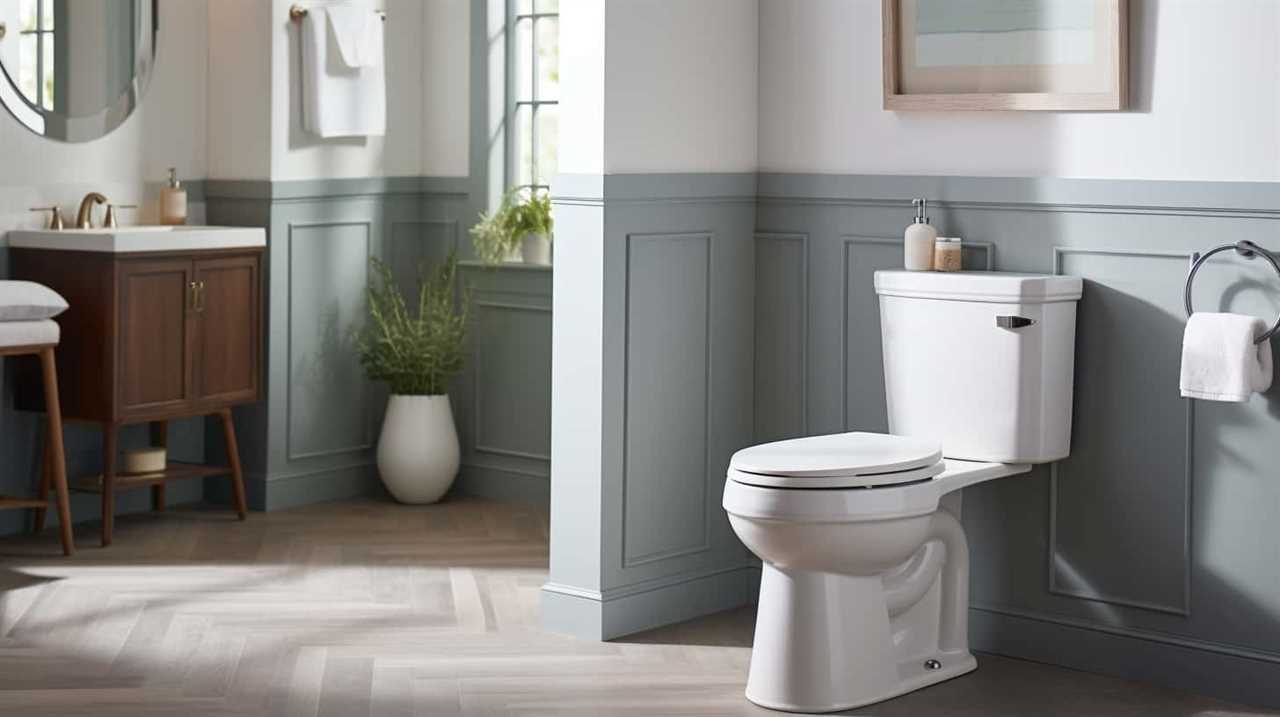
Being mindful of what goes down the toilet can ensure proper functionality and protect against potential health hazards.
How Flushing Objects Can Damage Your Plumbing System
Flushing objects down the toilet can cause significant damage to our plumbing system. Not only can it lead to costly repairs, but it can also pose potential health hazards. When objects are flushed, they can get stuck in the pipes, leading to blockages and clogs. This can result in overflowing toilets, sewage backups, and even burst pipes. The table below illustrates some of the potential consequences of flushing objects down the toilet:
| Potential Consequences | Description | Financial Costs |
|---|---|---|
| Blocked pipes | Objects can get stuck in the pipes, causing blockages and clogs. | Expensive plumbing repairs |
| Overflowing toilets | Blocked pipes can cause toilets to overflow, resulting in unsanitary conditions. | Cleanup costs and potential health hazards |
| Sewage backups | Blockages can lead to sewage backups, causing damage to the plumbing system. | Costly repairs and health risks |
| Burst pipes | Excessive pressure from blockages can cause pipes to burst, leading to extensive water damage. | Expensive repairs and potential property damage |
| Environmental impact | Flushing non-biodegradable objects can harm the environment. | Potential fines and ecological consequences |
To avoid these potential health hazards and financial costs, it is crucial to only flush toilet paper and human waste down the toilet.
Potential Environmental Impacts of Flushing Objects
Flushing objects down the toilet can have serious environmental impacts, including water contamination risks and sewer system damage.
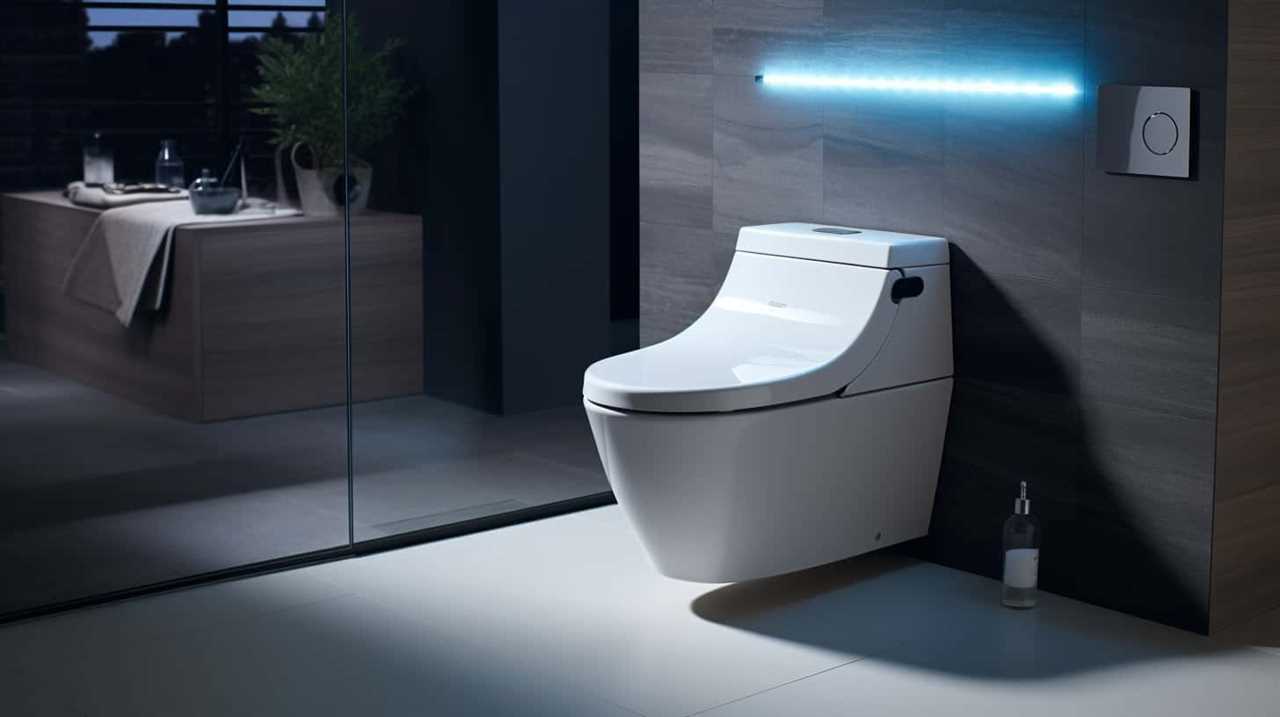
When non-biodegradable items are flushed, they can end up in water bodies, polluting the water and harming aquatic life.
Additionally, these objects can cause blockages in the sewer system, leading to costly repairs and potential sewage overflows.
It’s important to be aware of the potential consequences and only flush toilet paper and human waste to protect the environment and maintain the proper functioning of the sewer system.
Water Contamination Risks
Our research shows that flushing objects down the toilet poses significant risks to the water supply’s contamination. Water pollution is a major concern when it comes to improper disposal of objects through flushing. When objects such as plastics, chemicals, or non-biodegradable materials are flushed, they can contaminate the water and contribute to water pollution. This can have detrimental effects on aquatic ecosystems and the health of humans and animals that rely on clean water sources. Additionally, the presence of hazardous materials in the water supply can lead to serious health hazards if consumed or used for bathing.

It’s crucial to understand the potential environmental impacts of flushing objects and take necessary measures to prevent water contamination. Transitioning to the subsequent section, let’s now discuss the potential sewer system damage caused by flushing objects down the toilet.
Sewer System Damage
To understand the potential environmental impacts of flushing objects, we must consider the significant damage that can occur to sewer systems. Flushing non-flushable items down the toilet can lead to serious consequences for sewage systems. These systems are designed to handle specific types of waste, and when foreign objects are introduced, they can cause blockages, clogs, and damage to the infrastructure.
Sewage system maintenance is crucial to prevent and address these issues. Clearing out blockages and repairing sewer damage requires skilled professionals and specialized equipment. The cost of repairing sewer damage can be substantial, not to mention the potential for disruptions to the community and the environment.
The risk of clogged toilets and sewer backups further underscores the importance of proper waste disposal. Flushing objects down the toilet may seem convenient in the moment, but the long-term consequences can be costly and harmful.

The Risk of Clogged Toilets and Sewer Backups
While it may be tempting to flush various objects down the toilet, it’s important to consider the risk of clogged toilets and sewer backups. Flushing non-flushable items can cause blockages in the plumbing system, leading to clogs and potential sewer backups. These backups can result in costly repairs, unpleasant odors, and unsanitary conditions.
Additionally, clogged toilets waste water and contribute to water scarcity issues. To prevent clogs and backups, it’s crucial to educate children and promote responsible flushing habits. Teach them that only toilet paper and bodily waste should be flushed down the toilet. Encourage the use of trash cans for disposing of non-flushable items.
Alternatives to Flushing Objects Down the Toilet
When it comes to disposing of objects that shouldn’t be flushed down the toilet, there are safer alternatives available.
One option is to place the unwanted items in a sealed bag and throw them in the trash.

Another alternative is to take the objects to a designated hazardous waste disposal facility.
It’s important to consider the environmental impact of improper disposal and choose the appropriate method to ensure safety and sustainability.
Safer Disposal Methods
We prefer using safer disposal methods instead of flushing objects down the toilet. Proper waste disposal is essential for maintaining a clean and hygienic environment. Here are some alternatives to flushing objects down the toilet:
| Safer Disposal Methods | Benefits |
|---|---|
| Recycling | Reduces waste and conserves resources |
| Composting | Turns organic waste into nutrient-rich soil |
| Donating or Selling | Gives unwanted items a second life |
Recycling is a great way to reduce waste and conserve resources. By separating recyclables such as paper, plastic, and glass, we can ensure that these materials are properly processed and reused. Composting is another eco-friendly option, allowing organic waste like food scraps and yard trimmings to decompose naturally and become nutrient-rich soil. Donating or selling unwanted items not only reduces waste but also benefits others who may find value in them. By incorporating these safer disposal methods into our daily lives, we can contribute to a cleaner and more sustainable future.
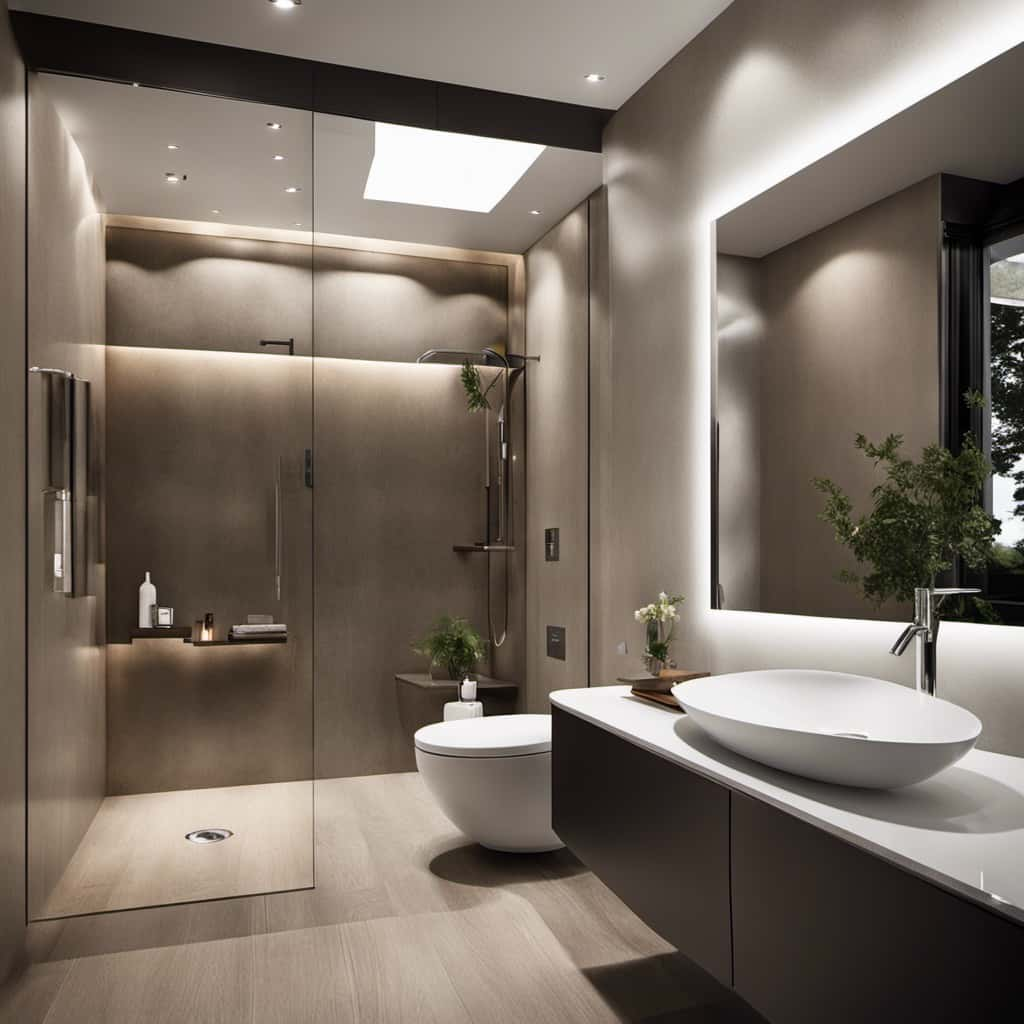
Environmental Impact Considerations
To minimize the environmental impact of disposing objects, we should consider alternative methods rather than flushing them down the toilet. Flushing objects down the toilet can lead to water pollution and ecosystem disruption.
When objects are flushed, they can end up in water treatment facilities where they can cause damage to equipment and clog pipes. These objects can also make their way into rivers, lakes, and oceans, polluting the water and harming aquatic life.
To avoid these negative consequences, it’s important to dispose of objects properly. This can involve using designated waste disposal bins or recycling centers. By choosing alternative methods, we can help protect our water sources and prevent further damage to the delicate ecosystems they support.
In the next section, we’ll explore the role of water conservation in toilet waste disposal, further highlighting the importance of responsible practices.
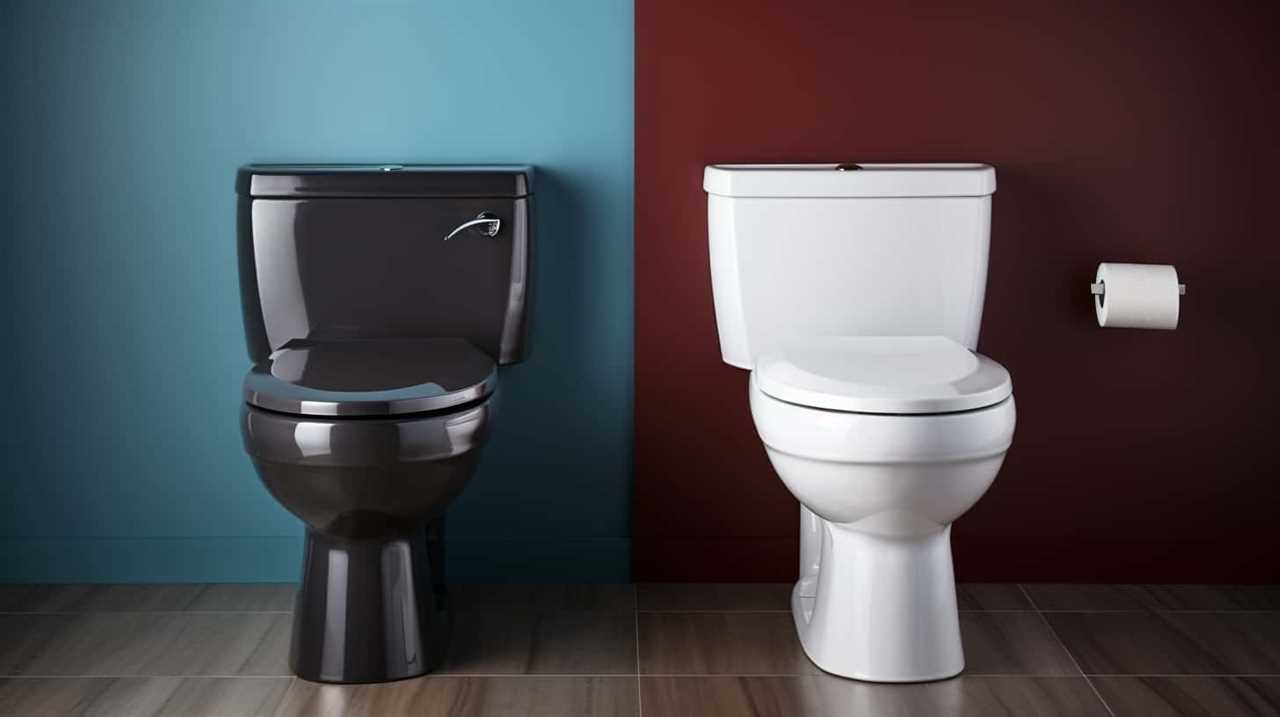
The Role of Water Conservation in Toilet Waste Disposal
The role of water conservation in toilet waste disposal is an essential aspect of our daily lives. By practicing water conservation, we can minimize our impact on the environment and ensure efficient waste management. Here are three crucial reasons why water conservation plays a significant role in toilet waste disposal:
- Reducing water usage: Conserving water in our toilets helps us save this precious resource and reduce our overall water consumption.
- Minimizing strain on waste treatment systems: By using water efficiently, we reduce the amount of water that needs to be treated in waste management facilities, easing the burden on these systems.
- Preserving ecosystems: Water conservation in toilet waste disposal helps protect our natural ecosystems by reducing the amount of water and waste that enters rivers, lakes, and other bodies of water.
Understanding the importance of water conservation in toilet waste disposal sets the foundation for educating children about proper toilet usage.
Educating Children About Proper Toilet Usage
At home, our family teaches our kids about the importance of proper toilet usage. Toilet training and teaching hygiene are essential skills that we believe every child should learn.
We start by explaining the purpose of the toilet and how it functions. We demonstrate the correct way to use the toilet, emphasizing the importance of sitting properly and wiping correctly.
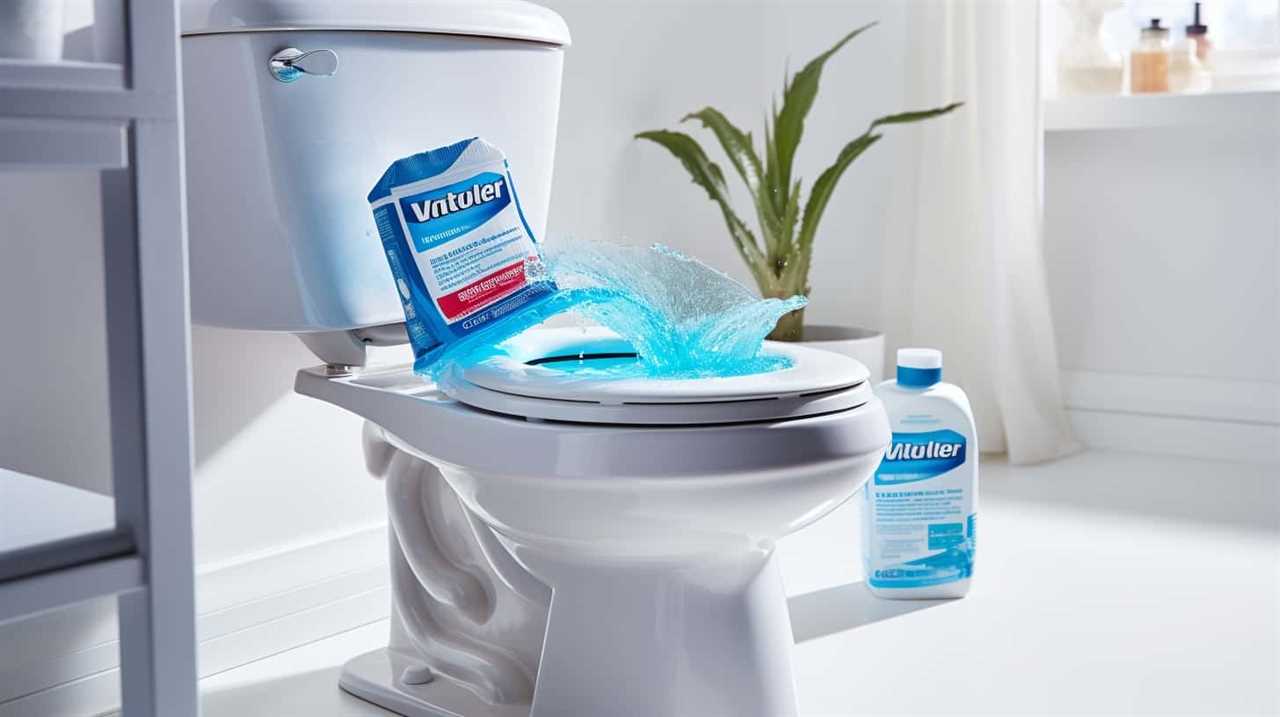
We teach our children to flush after each use and to use an appropriate amount of toilet paper. We also educate them about the consequences of flushing objects down the toilet, such as clogging the pipes and damaging the plumbing system.
The Impact of Flushing Medications Down the Toilet
Flushing medications down the toilet can have significant environmental consequences. When pharmaceutical waste enters our water systems, it can lead to water pollution and harm aquatic life. Here are three reasons why flushing medications down the toilet should be avoided:
- Water Pollution: Medications contain chemicals that can contaminate our water sources. These chemicals can persist in the environment and have detrimental effects on aquatic ecosystems.
- Harm to Aquatic Life: Pharmaceutical waste can disrupt the balance of ecosystems and harm fish, amphibians, and other aquatic organisms. It can interfere with their reproduction, growth, and overall health.
- Human Health Risks: The presence of pharmaceutical waste in our water sources can potentially pose risks to human health. Consuming or coming into contact with contaminated water can lead to unintended exposure to medications and their potentially harmful effects.
To protect our environment and ensure the safety of our water sources, it’s crucial to dispose of medications properly through designated collection programs or pharmacies that accept unused medications.
Flushing Personal Hygiene Products: What You Need to Know
When it comes to disposing of personal hygiene products down the toilet, there are important considerations to keep in mind. Flushing personal hygiene products can lead to water pollution and can have negative impacts on the environment.

Many personal hygiene products, such as wet wipes, tampons, and pads, aren’t designed to break down easily in water. Flushing these products can cause clogs in the plumbing system, leading to costly repairs. Additionally, these products can end up in our waterways, contributing to water pollution and harming aquatic life.
To prevent these issues, it’s crucial to follow proper hygiene practices and dispose of personal hygiene products in the trash. This simple action can help protect our environment and ensure the proper functioning of our plumbing systems.
The Consequences of Flushing Non-Biodegradable Items
Flushing non-biodegradable items down the toilet can have serious consequences for the environment, plumbing systems, and public health.
When these items are flushed, they can end up in waterways, polluting ecosystems and harming aquatic life.
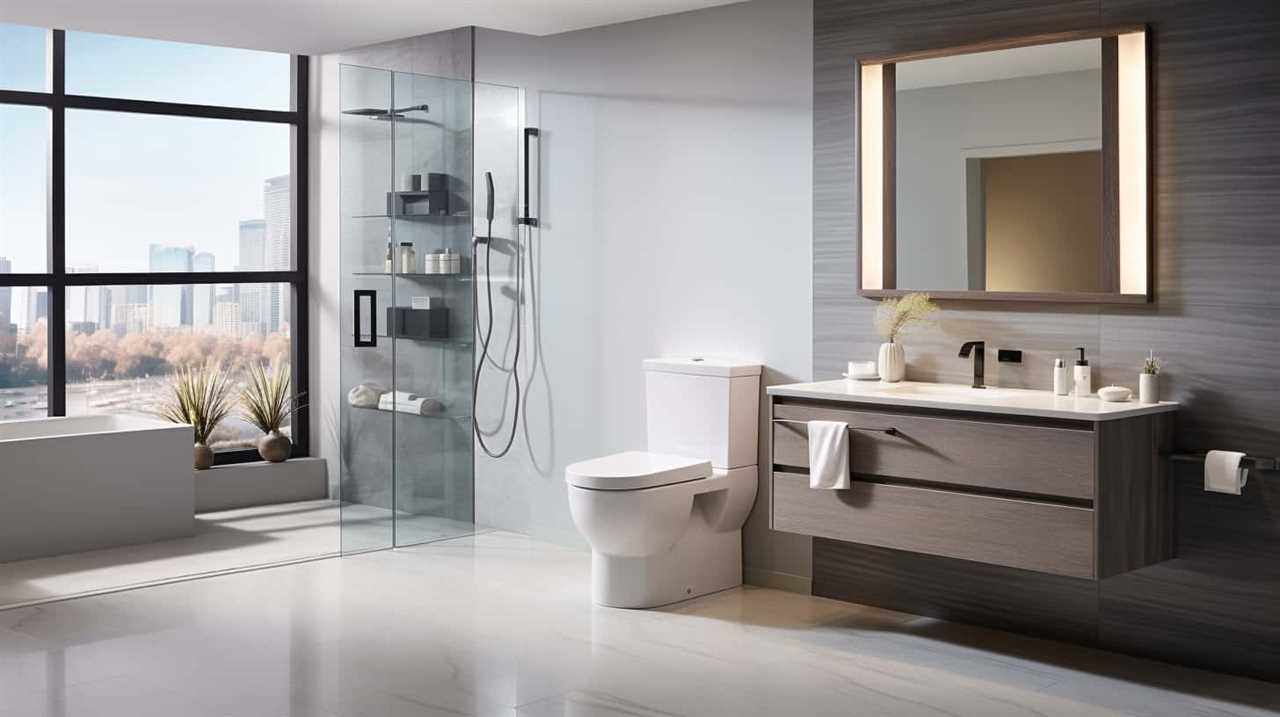
Additionally, non-biodegradable items like wipes and sanitary products can cause clogs in pipes and sewer systems, leading to costly repairs.
Furthermore, the improper disposal of these items can pose health risks, as they may contain harmful chemicals or bacteria that can contaminate water sources.
Environmental Impact of Flushing
The improper disposal of non-biodegradable items through toilet flushing can have detrimental environmental consequences. Flushing non-biodegradable items contributes to water pollution, which poses a serious threat to aquatic ecosystems. Here are three reasons why flushing these items can have a negative impact on the environment:
- Water pollution: Non-biodegradable items, such as plastics and chemicals, can contaminate water sources, leading to harmful effects on marine life and other organisms that rely on clean water for survival.
- Ecosystem damage: When non-biodegradable items are flushed down the toilet, they can end up in rivers, lakes, and oceans, disrupting delicate ecosystems and causing harm to plants, animals, and other organisms.
- Habitat destruction: The presence of non-biodegradable items in water bodies can destroy habitats, making it difficult for aquatic species to thrive and survive.
Improper disposal of non-biodegradable items through toilet flushing not only affects water quality but also poses a significant threat to the overall health of our ecosystems.
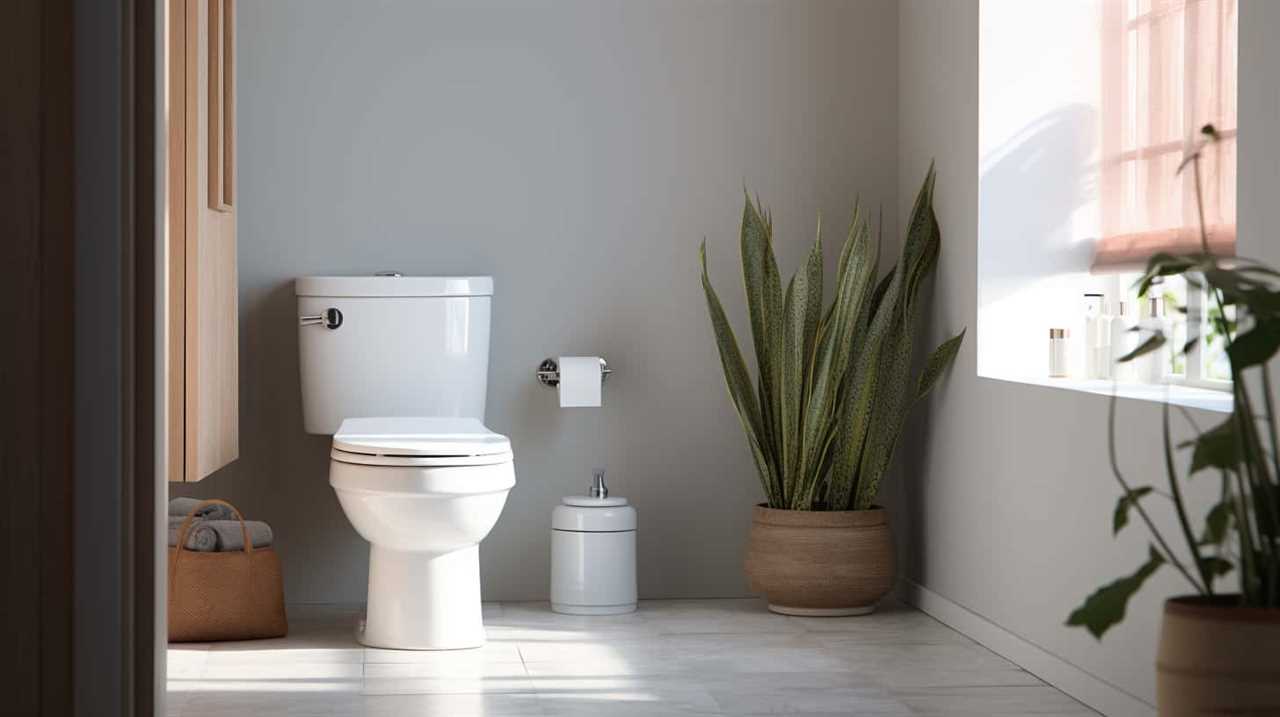
Now, let’s explore the next topic: clogging and plumbing issues.
Clogging and Plumbing Issues
Toilet flushing non-biodegradable items can lead to a multitude of clogging and plumbing issues. When items such as wipes, feminine hygiene products, or paper towels are flushed down the toilet, they can cause blockages in the pipes. These blockages restrict the flow of water, leading to inefficient flushing and potential backups.
Additionally, non-biodegradable items can accumulate in the plumbing system over time, causing further clogs and reducing the overall effectiveness of the system. Not only does this result in increased water usage due to multiple flushes, but it also puts a strain on the plumbing system, requiring frequent maintenance and repairs.
To avoid these issues, it’s essential to only flush toilet paper and waste, and to regularly maintain the plumbing system to prevent clogs and ensure efficient water usage.
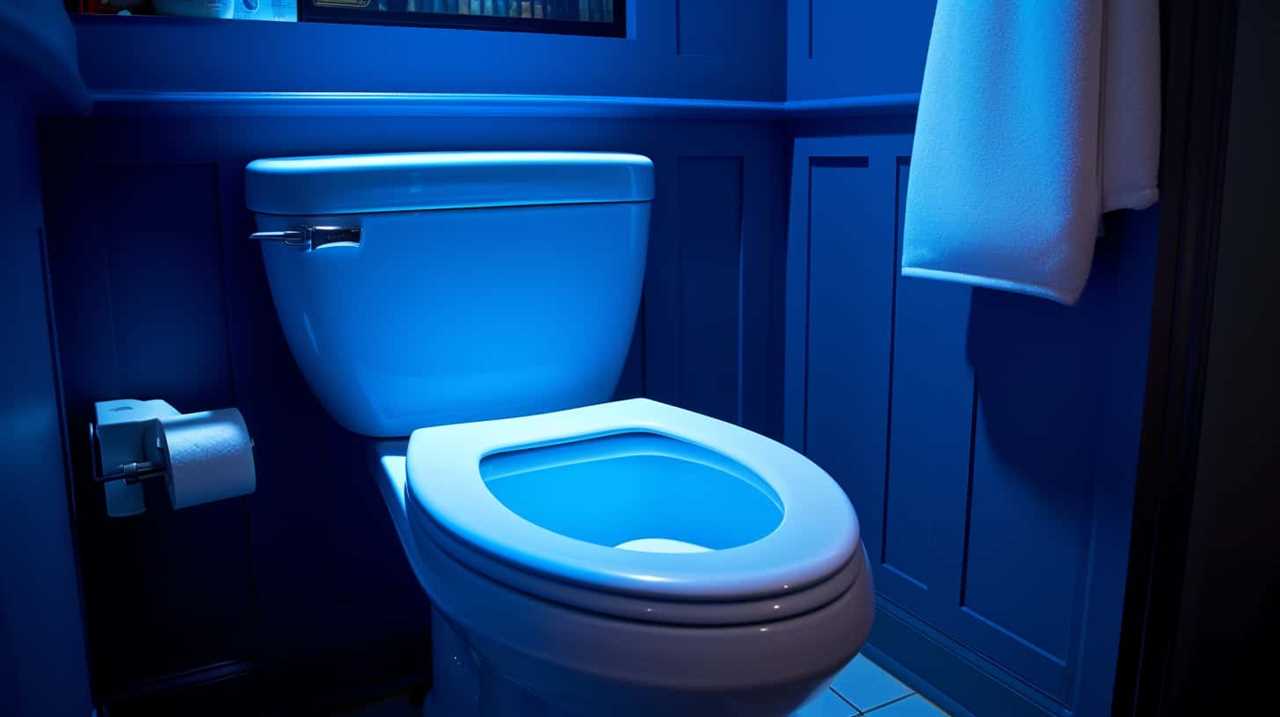
Public Health Concerns
When non-biodegradable items are flushed down the toilet, it can have detrimental consequences for public health. It’s crucial to understand the risks associated with improper waste management and the potential harm it can cause to individuals and communities.
Here are three important public health concerns to consider:
- Contamination of water sources: Flushing non-biodegradable items can lead to the contamination of water sources, including rivers, lakes, and underground aquifers. This can negatively impact drinking water quality and increase the risk of waterborne diseases.
- Blockage of sewage systems: Non-biodegradable items such as wipes, tampons, and condoms can clog sewage systems, leading to backups and overflows. This can result in the release of harmful bacteria and pathogens into the environment, posing a serious health risk.
- Damage to wastewater treatment infrastructure: Flushing non-biodegradable items can cause damage to wastewater treatment infrastructure, leading to costly repairs and maintenance. This can divert resources from other important public health initiatives.
To protect public health, it’s essential to practice proper waste management by disposing of non-biodegradable items in designated trash receptacles.
Responsible Disposal Methods for Various Objects
At our house, we dispose of various objects responsibly by using appropriate methods. Responsible waste management is crucial to minimize environmental impact and ensure public health and safety.

When it comes to alternative disposal methods, it’s important to consider recycling, composting, and hazardous waste facilities. Recycling allows for the recovery of valuable materials from objects such as plastic, glass, and paper, reducing the need for new resource extraction.
Composting is an excellent option for organic waste like food scraps and yard trimmings, as it produces nutrient-rich soil for gardening.
Additionally, hazardous waste, like batteries and chemicals, should be taken to designated facilities to prevent contamination of the environment and water sources.
Conclusion
In conclusion, it’s crucial to remember that only human waste and toilet paper should be flushed down the toilet.

Flushing objects such as medications, personal hygiene products, and non-biodegradable items can lead to serious damage to your plumbing system and have negative environmental impacts.
While some may argue that it’s convenient to flush certain objects, it’s important to prioritize responsible waste disposal methods to protect our plumbing systems and the environment for future generations.
With an impeccable eye for detail and a passion for bathroom-related, Ava leads our editorial team gracefully and precisely.
Under her guidance, Best Modern Toilet has flourished as the go-to resource for modern bathroom enthusiasts. In her free time, you might find Ava exploring antique shops and looking for vintage bathroom fixtures to add to her collection.
FAQ - Advanced Bathroom Queries
Can You Force Flush a Toilet
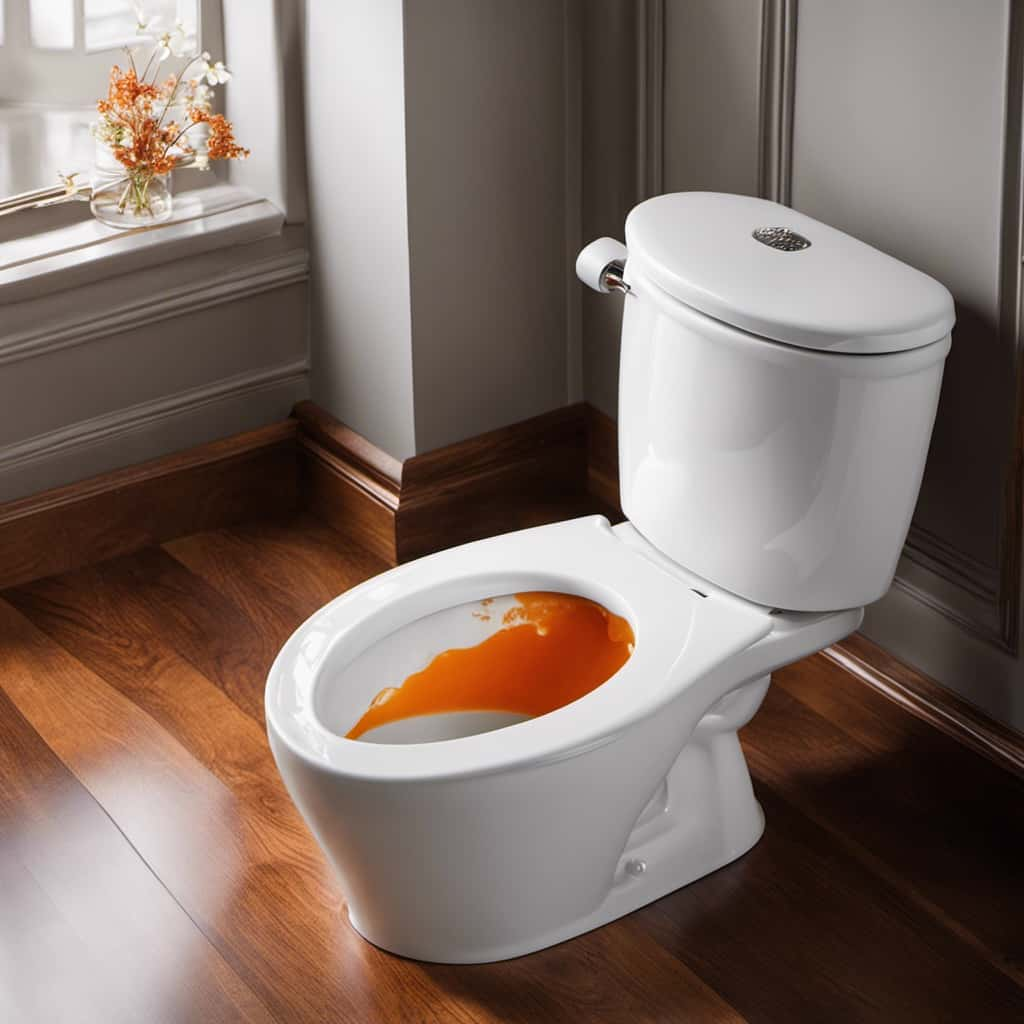
Yes, you can unleash the power of a force flush on your toilet! Have you ever thought about it before? We’re here to let you know that it is possible!
In this article, we will delve into the mechanics of a toilet flush and explain when a force flush is necessary.
We’ll also provide you with a step-by-step guide and tips for a successful force flush.
So, buckle up and get ready to master the art of force flushing your toilet!
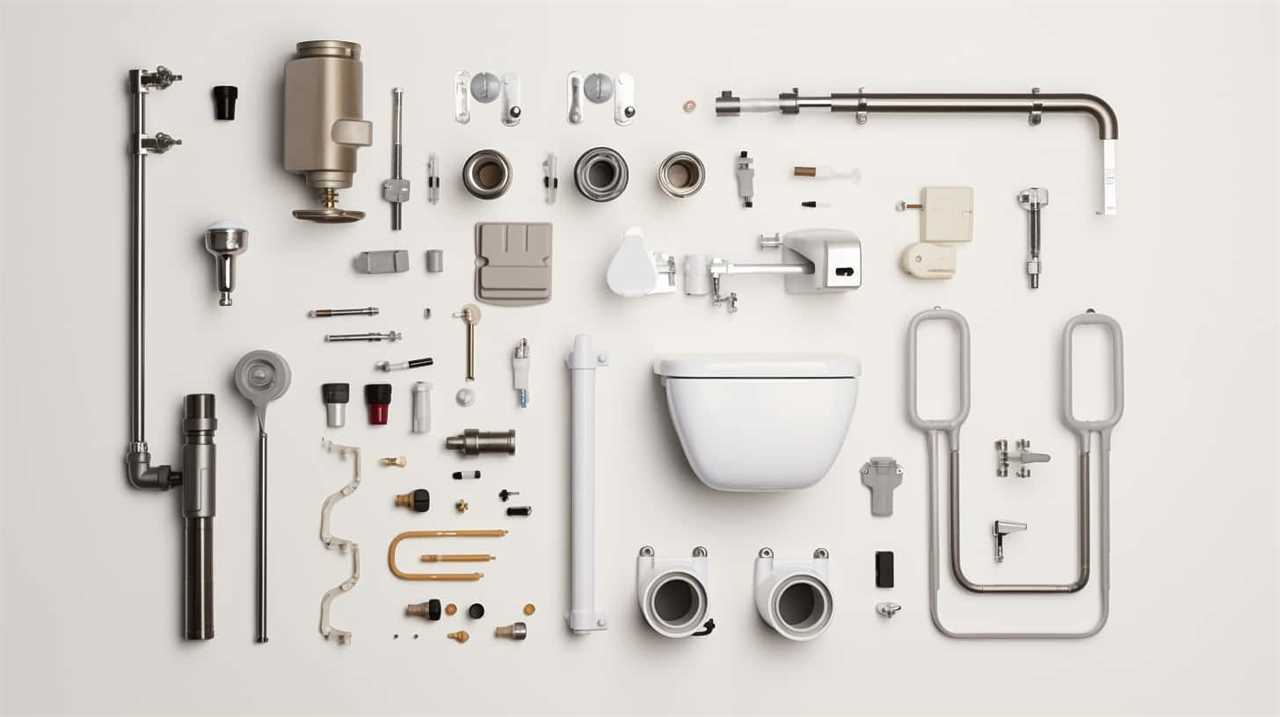
Key Takeaways
- The flush lever lifts the flapper, allowing water to rush into the bowl.
- Troubleshooting weak flushes, inconsistent water levels, or clogs involves checking the water supply, flush valve, and tank components.
- If conventional methods fail to unclog a toilet, calling a professional plumber may be necessary.
- Tools and equipment for force flushing a toilet include a plunger, high-pressure water source, rubber gloves, towels, and a bucket or pail.
Understanding the Mechanics of a Toilet Flush
To understand the mechanics of a toilet flush, we’ll delve into the workings of its water flow and pressure.
The toilet flush mechanism is a complex system that relies on the proper functioning of several components. When the flush lever is pressed, it lifts the flapper, allowing water from the tank to rush into the bowl. This creates a strong force that pushes waste down the drain.
However, if you’re experiencing issues with your toilet flush, troubleshooting the problem can be a bit challenging. Common issues include weak flushes, inconsistent water levels, or clogs.
It’s important to check the water supply, the flush valve, and the tank components for any signs of damage or malfunction. By understanding the inner workings of the toilet flush mechanism, you can effectively troubleshoot and fix any issues that arise.

Identifying When a Force Flush Is Necessary
When identifying the instances in which a force flush is necessary, we must consider the factors that may contribute to a weak or ineffective flush. Signs of a clogged toilet include water that rises to the rim or drains slowly, gurgling sounds, or a foul odor. If these signs persist despite attempts to unclog the toilet using a plunger or other methods, it may be time to call a professional plumber.
A professional plumber has the expertise and tools to effectively diagnose and resolve complex clogs that can’t be cleared through conventional means. Knowing when to call a professional plumber can prevent further damage to your plumbing system and ensure a proper force flush is performed if necessary.
With an understanding of when a force flush is needed, let’s now explore the tools and equipment required for this process.
Tools and Equipment for Force Flushing a Toilet
We will need specific tools and equipment to successfully force flush a toilet. Here are the essential items you’ll need:
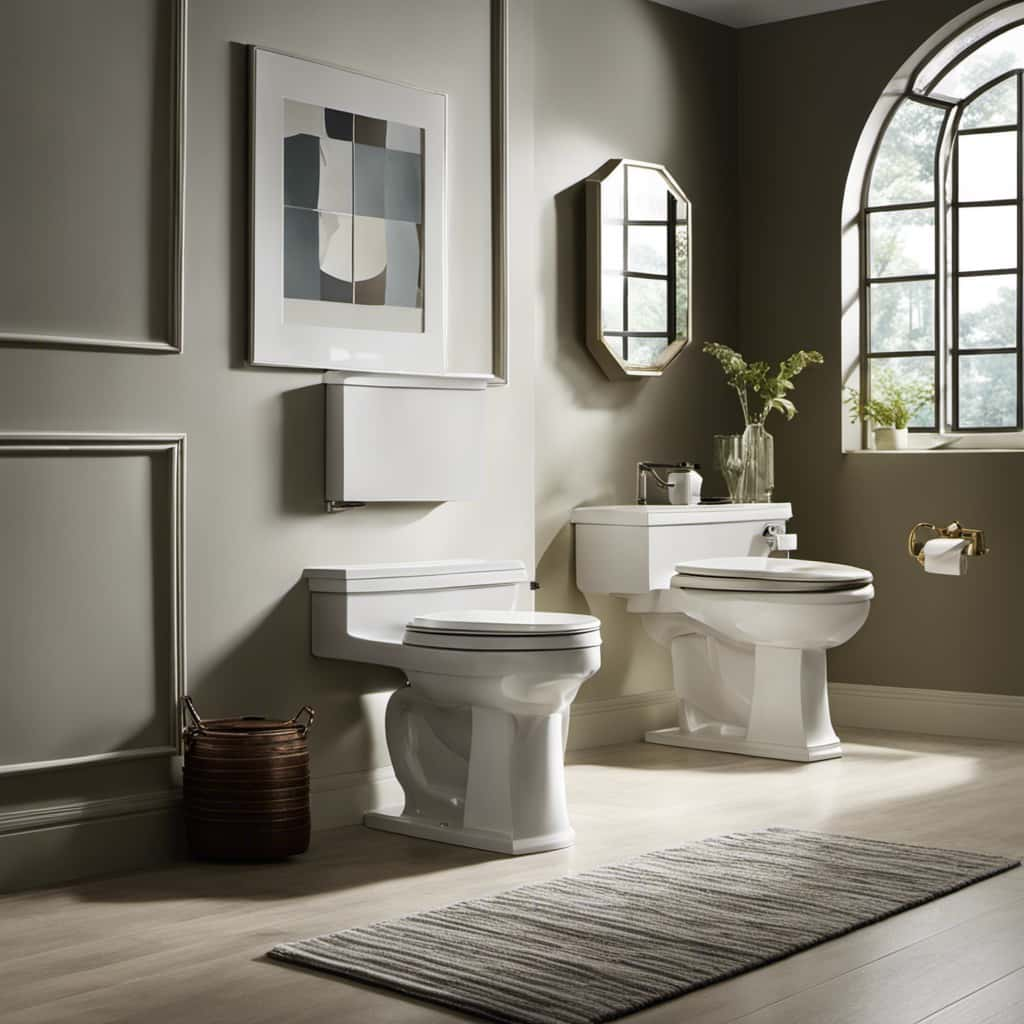
- Plunger: A plunger is a basic tool used to create pressure and force water through the drain. Choose a plunger with a flange or extension at the bottom for better seal and suction.
- High-pressure water source: To generate a forceful flush, you’ll need a high-pressure water source. This can be a handheld bidet sprayer, a pressure washer, or even a garden hose with a nozzle attachment.
- Rubber gloves: Protect your hands from any potential mess or bacteria by wearing rubber gloves. This will also provide a better grip on the plunger.
- Towels: Keep towels handy to clean up any spills or splashes that may occur during the force flushing process.
- Bucket or pail: Have a bucket or pail nearby to collect any excess water that may overflow during the force flushing.
Step-by-Step Guide to Force Flushing a Toilet
To successfully force flush a toilet, we will need to follow a step-by-step guide. Below is a table that outlines the process, along with some alternative methods for unclogging toilets.
| Step | Action |
|---|---|
| 1 | Put on protective gloves and eyewear. |
| 2 | Check for common toilet problems like a clogged trap or blocked vent pipe. |
| 3 | If the toilet is not clogged, try a plunger to force water down the drain. |
| 4 | If the plunger doesn’t work, try using a toilet auger to remove the blockage. |
| 5 | If all else fails, use a force flush by pouring a bucket of water into the toilet bowl. |
By following these steps, you can effectively force flush a toilet and resolve common toilet problems. In the next section, we will discuss some tips and precautions for a successful force flush.
Now, let’s move on to the tips and precautions for a successful force flush.
Tips and Precautions for a Successful Force Flush
Now, let’s explore some essential tips and precautions to ensure a successful force flush of the toilet.
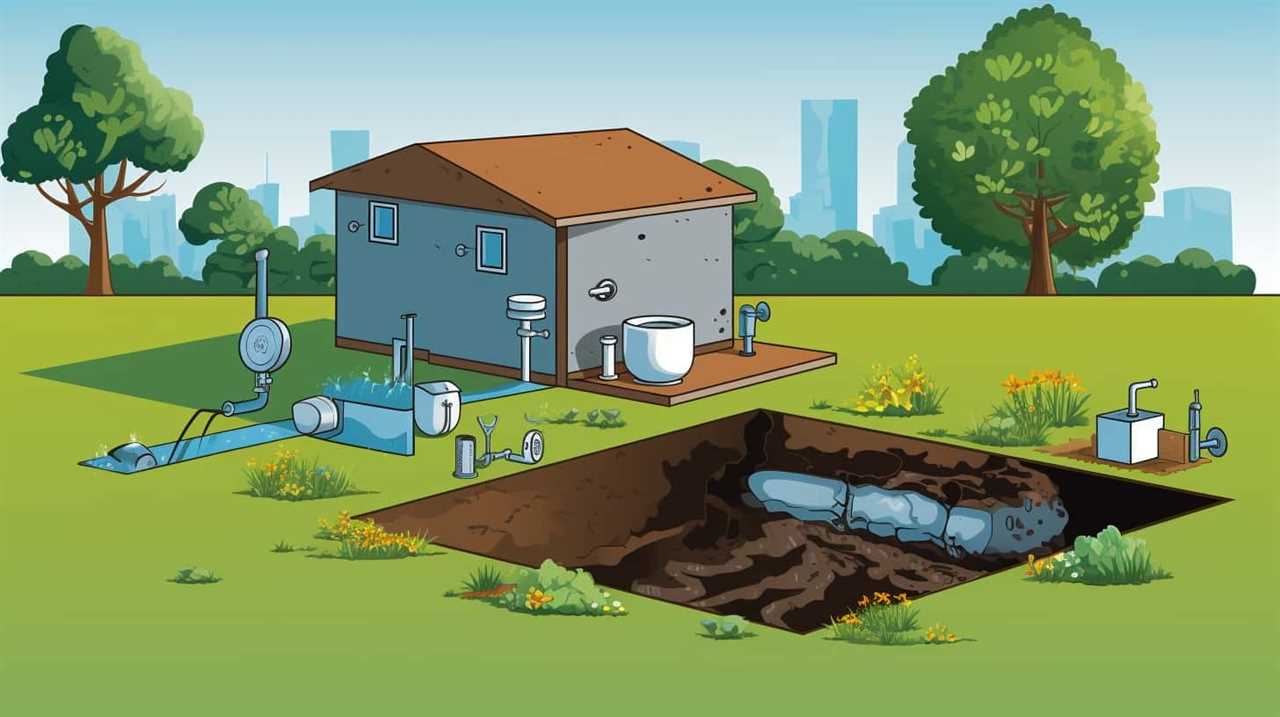
Here are some tips to prevent clogs and troubleshoot common issues:
- Use a plunger: A plunger is an effective tool for force flushing a toilet. Ensure a tight seal around the drain and use vigorous up-and-down motions to create suction and dislodge any blockage.
- Apply lubricant: If the plunger doesn’t work, try applying a small amount of lubricant, such as dish soap or petroleum jelly, around the rim of the plunger. This can improve suction and increase the chances of a successful force flush.
- Avoid excessive force: While force flushing is necessary in some cases, it’s important to avoid using excessive force as it can damage the toilet or pipes. Apply firm pressure, but be cautious.
- Check the water level: Before attempting a force flush, ensure that the water level in the toilet bowl isn’t too high. If it is, remove some water using a bucket or cup to prevent overflow.
- Call a professional: If force flushing doesn’t resolve the issue or if you encounter any other problems, it’s best to call a professional plumber. They have the expertise to handle complex toilet issues.
Frequently Asked Questions
How Long Does It Typically Take to Force Flush a Toilet?
Typically, it takes a few minutes to force flush a toilet. Common mistakes when trying to force flush include using excessive force, not checking the water level, or ignoring clogs. To troubleshoot a toilet that won’t force flush, check the water level, inspect for clogs, and ensure the flapper is functioning properly.
Can Force Flushing a Toilet Cause Any Damage to the Plumbing System?
Force flushing a toilet without proper knowledge or tools can potentially cause significant damage to the plumbing system. To prevent this, it’s crucial to understand the risks involved and take necessary precautions to ensure the integrity of the plumbing is maintained.
Is It Possible to Force Flush a Toilet Without Using Any Tools or Equipment?
Yes, you can force flush a toilet without using any tools or equipment. Some natural methods for unclogging toilets include using hot water, vinegar and baking soda, or a plunger. These DIY solutions can help resolve toilet flushing issues.
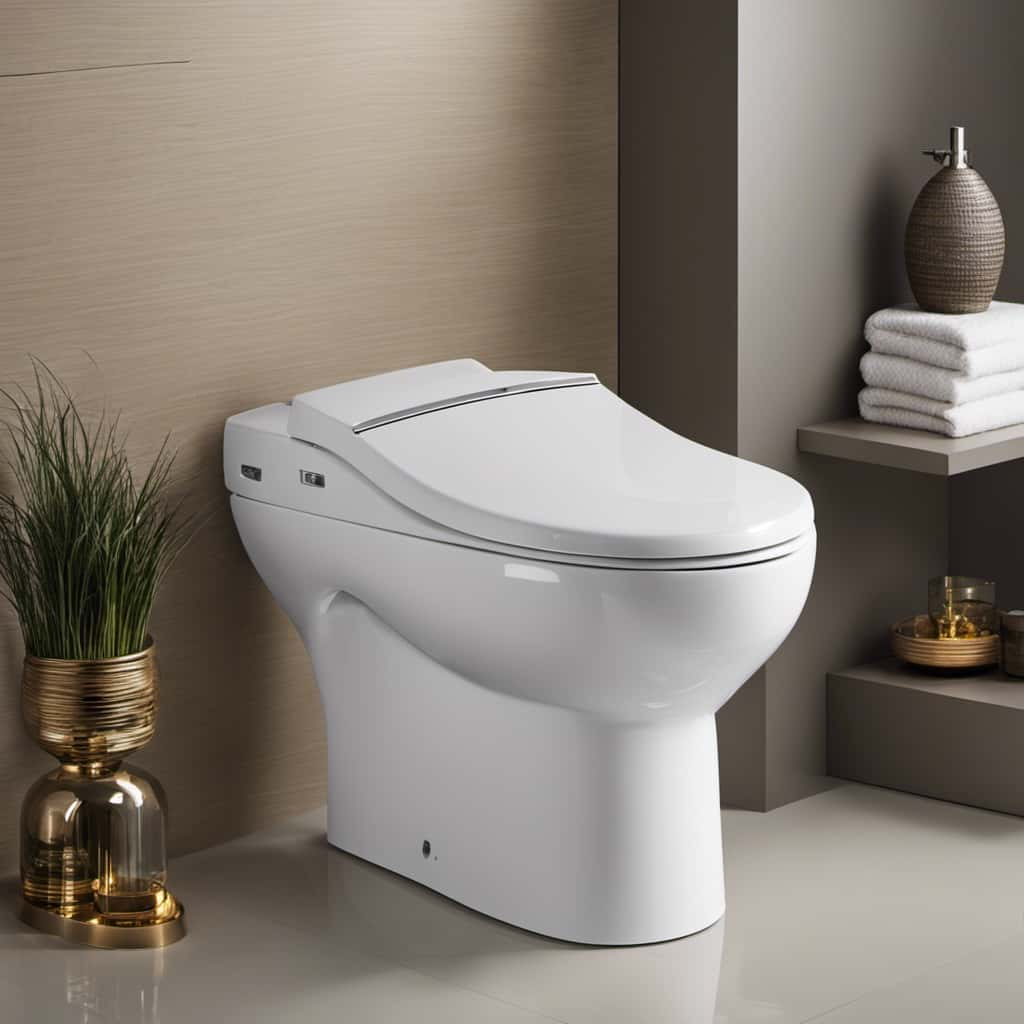
What Are Some Common Signs That Indicate a Force Flush Might Be Necessary?
Common signs that indicate a force flush might be necessary include water backing up, slow draining, and repeated clogs. To prevent clogs and avoid force flushing, proper maintenance and avoiding flushing non-flushable items are essential.
Are There Any Alternative Methods to Force Flushing a Toilet if the Recommended Tools Are Not Available?
Yes, there are alternative methods to force flush a toilet if the recommended tools are not available. DIY techniques such as pouring hot water or using a plunger can help resolve the issue.
Conclusion
In conclusion, understanding the mechanics of a toilet flush is essential for identifying when a force flush is necessary. By following a step-by-step guide and using the right tools and equipment, you can successfully force flush a toilet.
Remember to exercise caution and follow the tips provided for a smooth and efficient flush. With these techniques, you’ll be able to unclog even the most stubborn toilets with the force of a thousand storms!
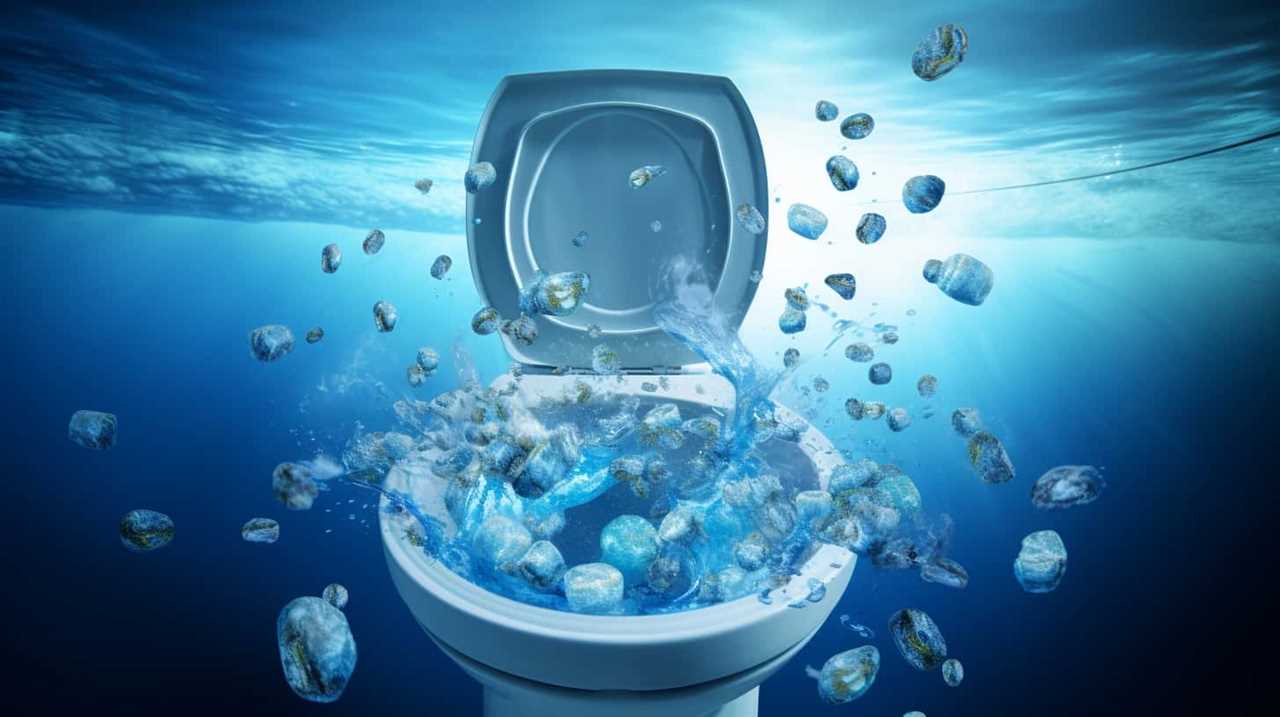
With an impeccable eye for detail and a passion for bathroom-related, Ava leads our editorial team gracefully and precisely.
Under her guidance, Best Modern Toilet has flourished as the go-to resource for modern bathroom enthusiasts. In her free time, you might find Ava exploring antique shops and looking for vintage bathroom fixtures to add to her collection.
FAQ - Advanced Bathroom Queries
Why Can’t You Flush Toilet Roll in Greece

Curious as to why toilet paper cannot be flushed in Greece? Allow us to provide some insight.
The plumbing infrastructure in Greece, although modern, is not designed to handle the disposal of toilet paper. Flushing it can lead to clogs and damage to the sewage system.
But don’t worry, we’ve got you covered. In this article, we’ll explore the reasons behind this practice, its environmental impact, and the alternatives commonly used in Greece.
Get ready to dive into the fascinating world of Greek toilet paper etiquette!
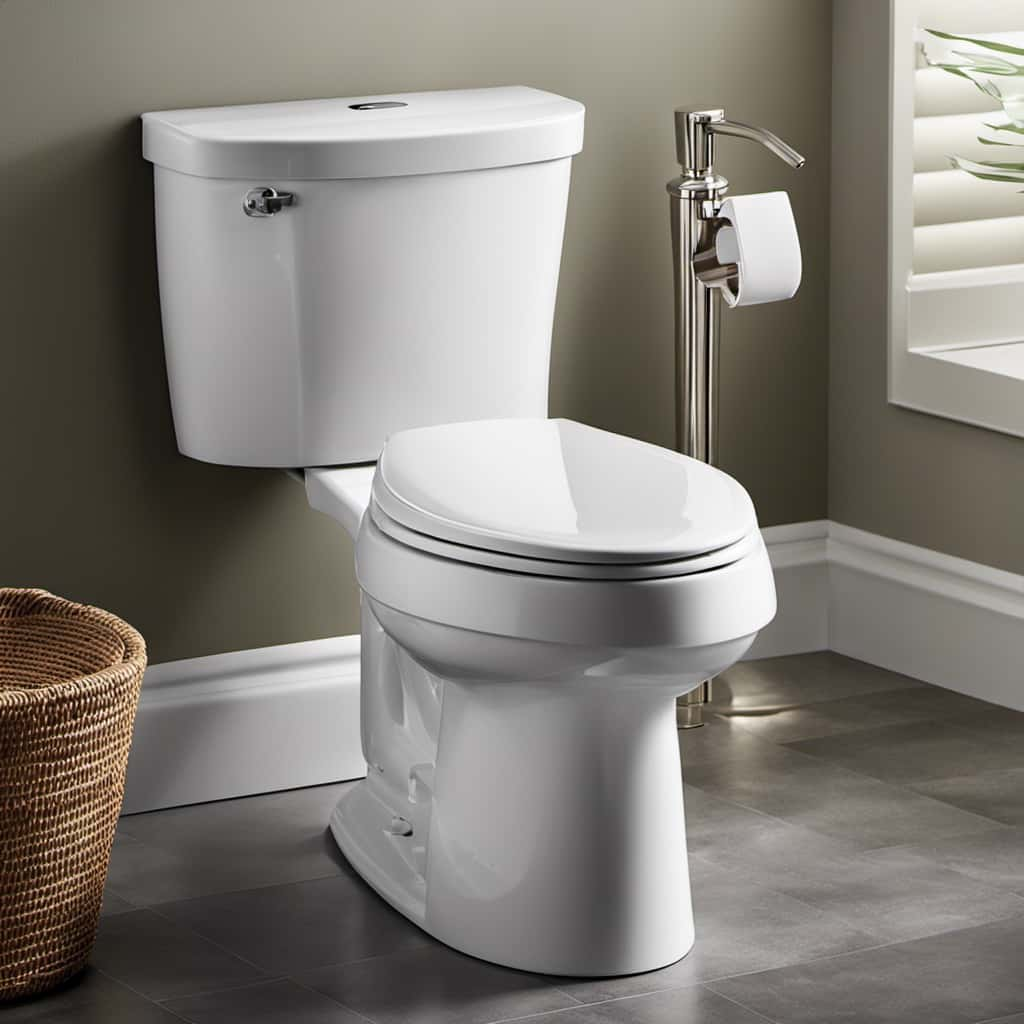
Key Takeaways
- Modern plumbing infrastructure in Greece is not designed to handle the disposal of toilet paper.
- Flushing toilet paper can lead to clogs and damage to the sewage system.
- Greece relies heavily on septic tanks, which have limited capacity to handle non-biodegradable materials like toilet paper.
- Aging infrastructure, limited capacity, and lack of maintenance contribute to the challenges in maintaining sewage systems in Greece.
Plumbing Infrastructure in Greece
Why is the plumbing infrastructure in Greece unable to handle flushing toilet paper?
Well, it all comes down to septic tank limitations and plumbing regulations.
Greece has a unique sewage system design that relies heavily on septic tanks. These tanks are designed to handle organic waste, such as human waste and toilet paper. However, they’ve limited capacity and aren’t equipped to handle large amounts of non-biodegradable materials like toilet paper.
To prevent clogging and potential damage to the system, it’s necessary to dispose of toilet paper in a separate bin provided in most restrooms. This may seem inconvenient, especially for those accustomed to simply flushing it down the toilet. However, it’s a necessary precaution to ensure the proper functioning of Greece’s plumbing infrastructure and sewage system design.
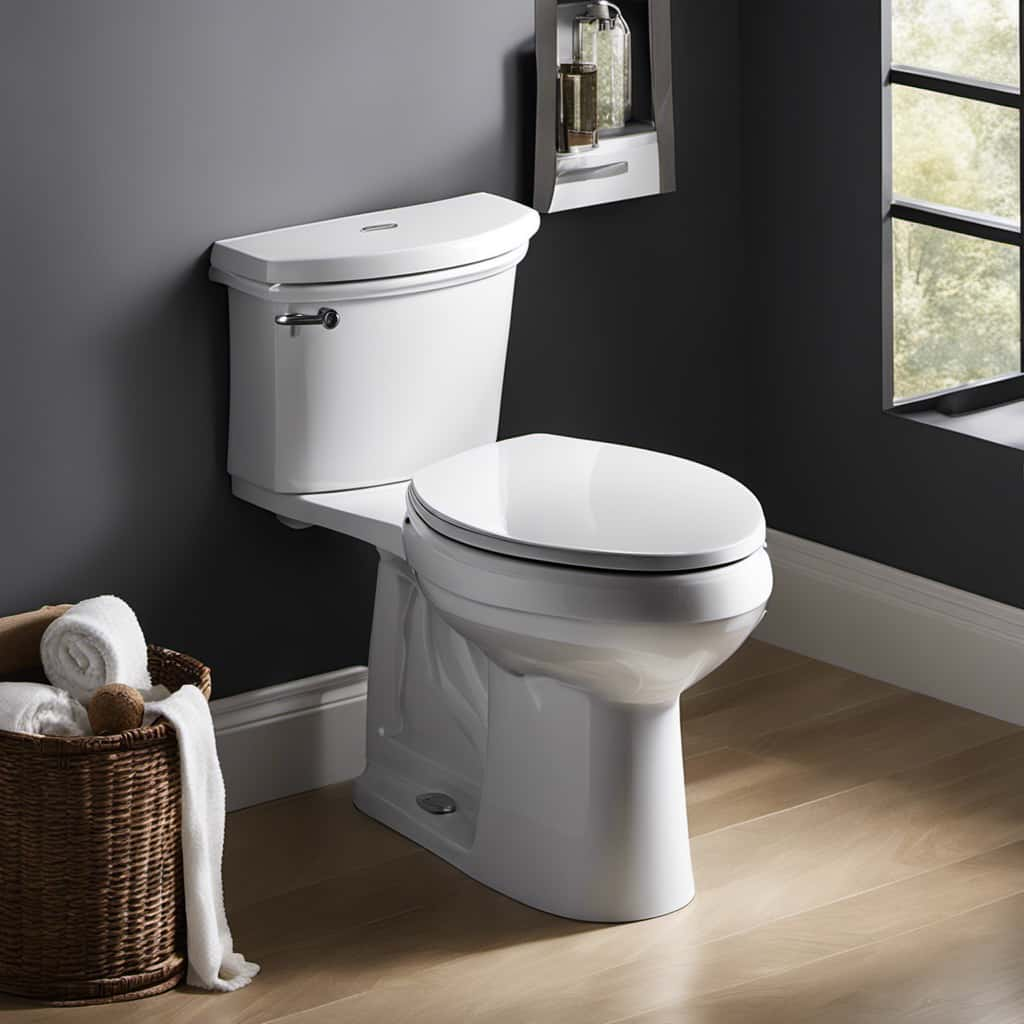
Now, let’s delve into the specifics of this unique sewage system design in Greece.
Sewage System Design in Greece
To understand the sewage system design in Greece and its limitations on flushing toilet paper, let’s delve into the unique infrastructure that relies on septic tanks and their capacity to handle non-biodegradable materials.
In Greece, municipal waste management is a significant challenge, and this extends to the sewage systems. Here are some key factors that contribute to the challenges in maintaining sewage systems in Greece:
- Aging infrastructure: Many sewage systems in Greece were built decades ago and haven’t been adequately updated or expanded to keep up with the growing population and increased waste production.
- Limited capacity: The septic tanks used in Greece have limited capacity to handle non-biodegradable materials like toilet paper, leading to frequent blockages and malfunctions.
- Lack of proper maintenance: Due to budget constraints and other priorities, the maintenance of sewage systems is often neglected, exacerbating the problems.
Understanding these challenges is crucial in comprehending the environmental impact of flushing toilet paper in Greece and finding sustainable solutions.

Environmental Impact of Flushing Toilet Paper
As we delve into the environmental impact of flushing toilet paper in Greece, it’s important to consider the consequences of disposing non-biodegradable materials into the aging sewage systems. The improper disposal of toilet paper can have detrimental effects on the environment. Flushing toilet paper contributes to paper waste management issues, as it adds to the volume of waste that needs to be treated and processed. This can put a strain on the already burdened sewage systems in Greece.
Additionally, excessive water usage from flushing toilet paper can conflict with water conservation measures that are in place to address water scarcity issues in the country. Therefore, it’s crucial to explore alternative methods of disposing of toilet paper to mitigate these environmental concerns.
Now, let’s transition into discussing the common alternatives to flushing toilet paper in Greece.
Common Alternatives to Flushing Toilet Paper in Greece
Now that we’ve explored the environmental impact of flushing toilet paper in Greece, let’s delve into the common alternatives we can use to avoid flushing it.

In Greece, bidet usage is a popular alternative to flushing toilet paper. Bidets are bathroom fixtures that spray water to clean oneself after using the toilet. They’re effective in removing waste without the need for toilet paper.
Another alternative is the use of composting toilets. These toilets are designed to convert human waste into compost that can be safely used as fertilizer. They use natural processes to break down waste, eliminating the need for flushing or traditional sewage systems.
Both bidet usage and composting toilets offer sustainable and hygienic alternatives to flushing toilet paper in Greece.
Cultural Norms and Etiquette Around Toilet Paper in Greece
In Greece, our cultural norms and etiquette dictate proper disposal methods for toilet paper. Unlike in many other countries, it isn’t common practice to flush toilet paper down the toilet. Instead, we’ve specific customs for disposing of it. This may seem strange to outsiders, but there are historical reasons behind this tradition.
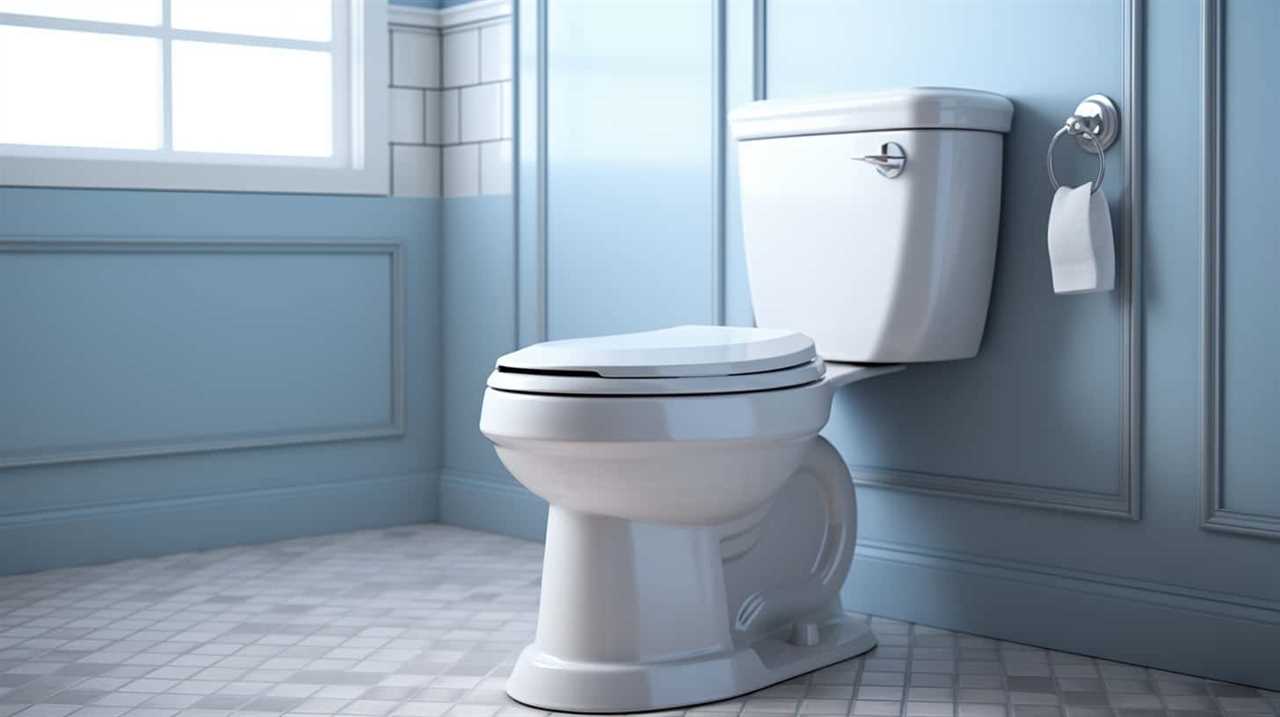
One of the main reasons for not flushing toilet paper in Greece is the age and condition of our plumbing systems. Many older buildings and houses have outdated pipes that aren’t designed to handle the flushing of toilet paper. Flushing it can lead to blockages and costly repairs.
Another reason is the concern for environmental impact. By not flushing toilet paper, we reduce the amount of waste that goes into the sewage system. This helps to protect our natural resources and minimize pollution.
Conclusion
In conclusion, when it comes to flushing toilet paper in Greece, it’s important to be mindful of the plumbing infrastructure and environmental impact. While it may not be the norm to flush toilet paper in Greece, there are alternative options available.
Understanding the cultural norms and etiquette around toilet paper can help us navigate this aspect of daily life in Greece with ease and respect. So, let’s embrace the unique customs and practices that make Greece truly special.

With an impeccable eye for detail and a passion for bathroom-related, Ava leads our editorial team gracefully and precisely.
Under her guidance, Best Modern Toilet has flourished as the go-to resource for modern bathroom enthusiasts. In her free time, you might find Ava exploring antique shops and looking for vintage bathroom fixtures to add to her collection.
FAQ - Advanced Bathroom Queries
Top Flush Toilet

Comparison of water usage: Top flush toilet versus traditional gravity flush toilet
Are you tired of dealing with outdated, inefficient toilets? Look no further than the top flush toilet.
With its innovative design and powerful flushing system, this modern fixture offers a more efficient and hygienic bathroom experience.
In this article, we will explore the benefits of a top flush toilet, discuss important features to consider when choosing one, and provide tips for maintenance and installation.
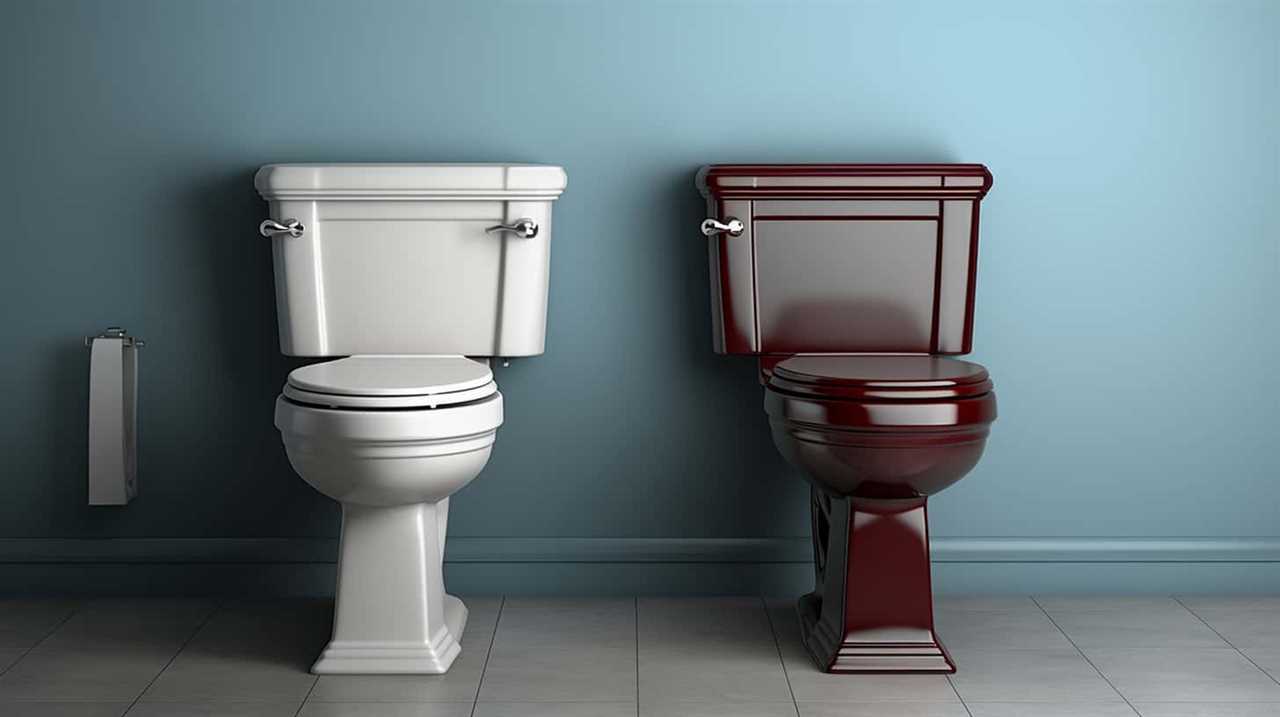
Let’s dive in and discover the world of top flush toilets together.
Key Takeaways
- Top flush toilets offer efficient water usage, resulting in significant water savings over time.
- They are reliable and durable, with a long lifespan, making them a cost-effective choice in the long run.
- Maintenance and repair are easy, with readily available parts. However, they may require more frequent cleaning due to their design.
- When choosing a top flush toilet, consider features such as water-saving technology, noise reduction features, and a chrome finish with an ergonomic handle and efficient flushing mechanism.
Benefits of a Top Flush Toilet
We love the benefits of a top flush toilet.
Top flush toilets, also known as gravity flush toilets, have several advantages over other types of toilets. One of the main advantages is their efficiency in water usage. These toilets typically use less water per flush compared to older models, resulting in significant water savings over time.
Another advantage is their reliability and durability. Top flush toilets are known for their sturdy construction and long lifespan, making them a cost-effective choice in the long run.

Additionally, these toilets are relatively easy to maintain and repair, with readily available parts. However, one disadvantage of top flush toilets is that they may sometimes require more frequent cleaning due to their design.
Features to Consider When Choosing a Top Flush Toilet
When choosing a top flush toilet, it’s important to consider the key features that will best suit your needs and preferences.
Two important features to consider are water saving technology and noise reduction features.
Water saving technology is designed to minimize water consumption by using less water per flush. This not only helps to conserve water, but also reduces your water bill. Look for toilets that are labeled as water-efficient or have a low water consumption rating.

Noise reduction features are also important, especially if you value a quiet bathroom experience. Look for toilets that have noise reduction technology, such as insulated tanks or soft-closing lids, to minimize noise during flushing.
How to Maintain and Clean Your Top Flush Toilet
To keep our top flush toilet clean and in proper working condition, regular maintenance is essential. Here are some effective cleaning techniques and common toilet maintenance issues to keep in mind:
- Use a toilet brush and cleaning solution to scrub the bowl thoroughly.
- Regularly clean the toilet tank to remove any build-up or sediment.
- Check the flapper valve for any signs of wear or damage and replace if necessary.
- Ensure that the water level in the tank is at the appropriate height.
- Clean the outside of the toilet, including the handle and seat, regularly to prevent the buildup of bacteria.
By following these maintenance practices, you can ensure that your top flush toilet remains clean and functional.
Now, let’s move on to the next section where we’ll discuss installation tips for a top flush toilet.

Installation Tips for a Top Flush Toilet
For optimal installation of a top flush toilet, it’s important to carefully position and secure the toilet onto the floor. Start by ensuring that the flange is properly aligned with the waste pipe and securely fastened. Use a wax ring to create a watertight seal between the toilet and the flange.
When placing the toilet onto the wax ring, make sure it sits evenly and firmly on the floor. Use the provided bolts to secure the toilet to the flange, being careful not to overtighten. Once the toilet is installed, test for any leaks by flushing and checking for water around the base. If you encounter any issues, such as a weak flush or water leakage, refer to the troubleshooting guide provided by the manufacturer.
To ensure a successful installation, avoid common mistakes such as using the wrong size wax ring or overtightening the bolts, which can crack the toilet. Properly aligning the flange and securely fastening the toilet are crucial for a leak-free and stable installation.
Now that we’ve covered the installation process, let’s move on to discussing top flush toilet brands to consider for your home.
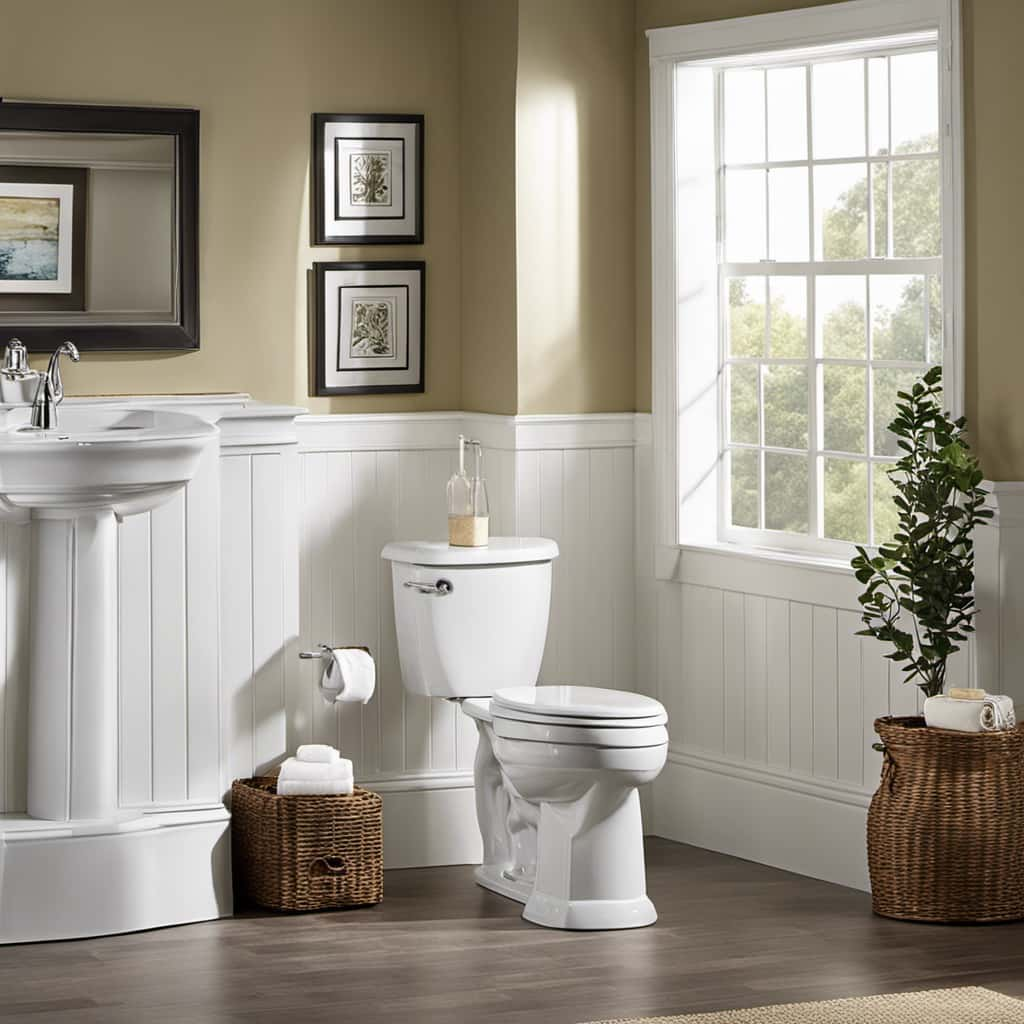
Top Flush Toilet Brands to Consider for Your Home
Now let’s explore some top flush toilet brands that you should consider for your home. When it comes to top flush toilet design, these brands have proven to be reliable and efficient. Here are five options to consider for your bathroom renovation:
- TOTO: Known for their innovative designs and water-saving features, TOTO offers a wide range of top flush toilets that combine style and performance.
- Kohler: With a reputation for quality and durability, Kohler toilets are designed to provide a powerful flush while minimizing water consumption.
- American Standard: This brand offers a variety of top flush toilets that are both efficient and affordable, making them a popular choice among homeowners.
- Gerber: Gerber toilets are known for their exceptional flushing power and reliable performance, making them a great option for those seeking a high-performing toilet.
- Mansfield: Mansfield toilets are known for their sleek design and powerful flush, making them a top choice for homeowners looking for both style and performance.
When comparing the cost of these top flush toilets, it’s important to consider factors such as water efficiency, durability, and overall quality.
Frequently Asked Questions
How Does a Top Flush Toilet Compare to a Standard Gravity-Flush Toilet in Terms of Water Efficiency?
In terms of water efficiency, we compared the top flush toilet to a standard gravity-flush toilet. Our findings indicate that the top flush toilet is more environmentally friendly due to its lower water consumption.
Can a Top Flush Toilet Be Easily Converted to a Dual-Flush System?
Converting a top flush toilet to a dual-flush system is a straightforward process. The benefits of dual flush include water conservation and cost savings. It allows users to choose between a partial flush for liquid waste and a full flush for solid waste.

Are Top Flush Toilets More Expensive to Purchase and Install Compared to Other Types of Toilets?
Top flush toilets may have higher purchase and installation costs compared to other types. Factors such as brand, material, and additional features can influence the price. It’s important to consider your budget and specific needs when choosing a toilet.
What Are the Common Issues or Problems That Can Occur With a Top Flush Toilet, and How Can They Be Resolved?
Common issues with top flush toilets can include clogging, leaking, and weak flushes. To fix them, check for blockages, replace faulty parts, or adjust the water level. Regular maintenance and careful use can prevent these problems.
Are There Any Specific Building Code Requirements or Regulations That Need to Be Followed When Installing a Top Flush Toilet?
When installing a top flush toilet, it is important to follow building code requirements and installation regulations. These ensure safety, proper functioning, and adherence to industry standards.
Conclusion
In conclusion, a top flush toilet offers numerous benefits, such as efficient water usage and a sleek design.
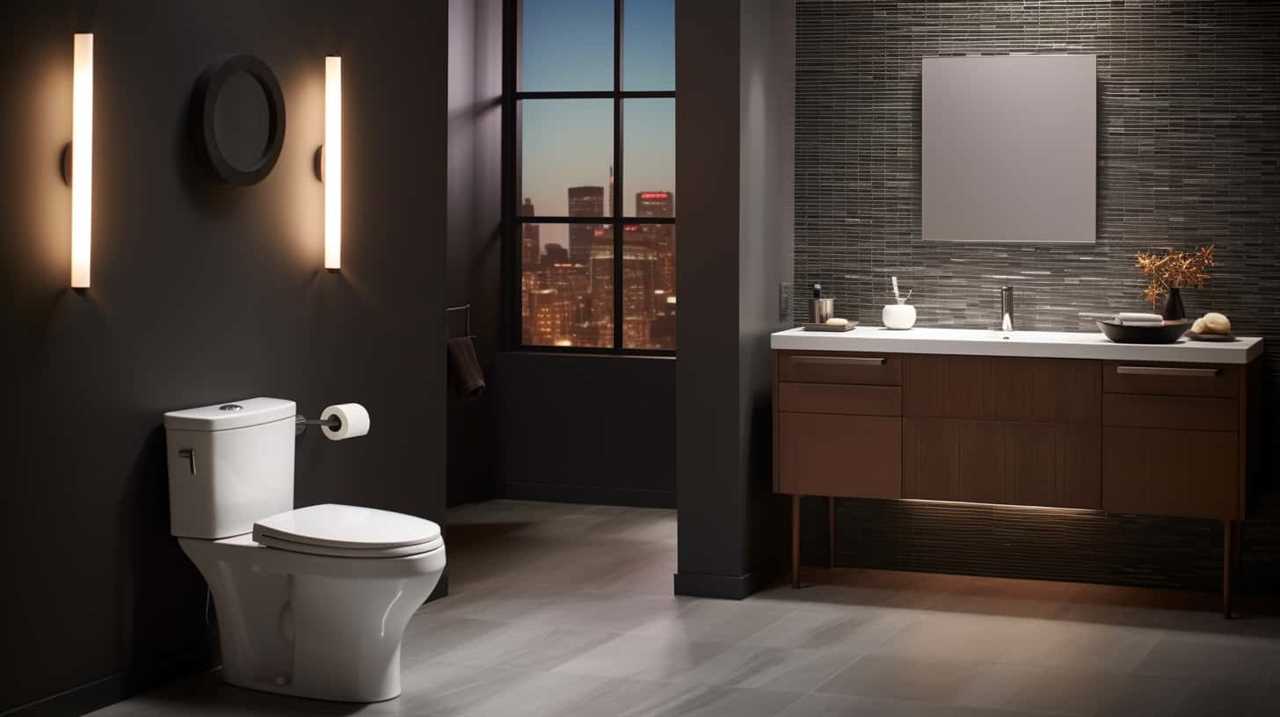
When choosing a top flush toilet, consider features like dual flushing options and easy-to-clean surfaces.
Maintenance and cleaning are crucial to ensure optimal performance and hygiene.
Proper installation is key for a seamless experience.
Explore top flush toilet brands that prioritize quality and durability.
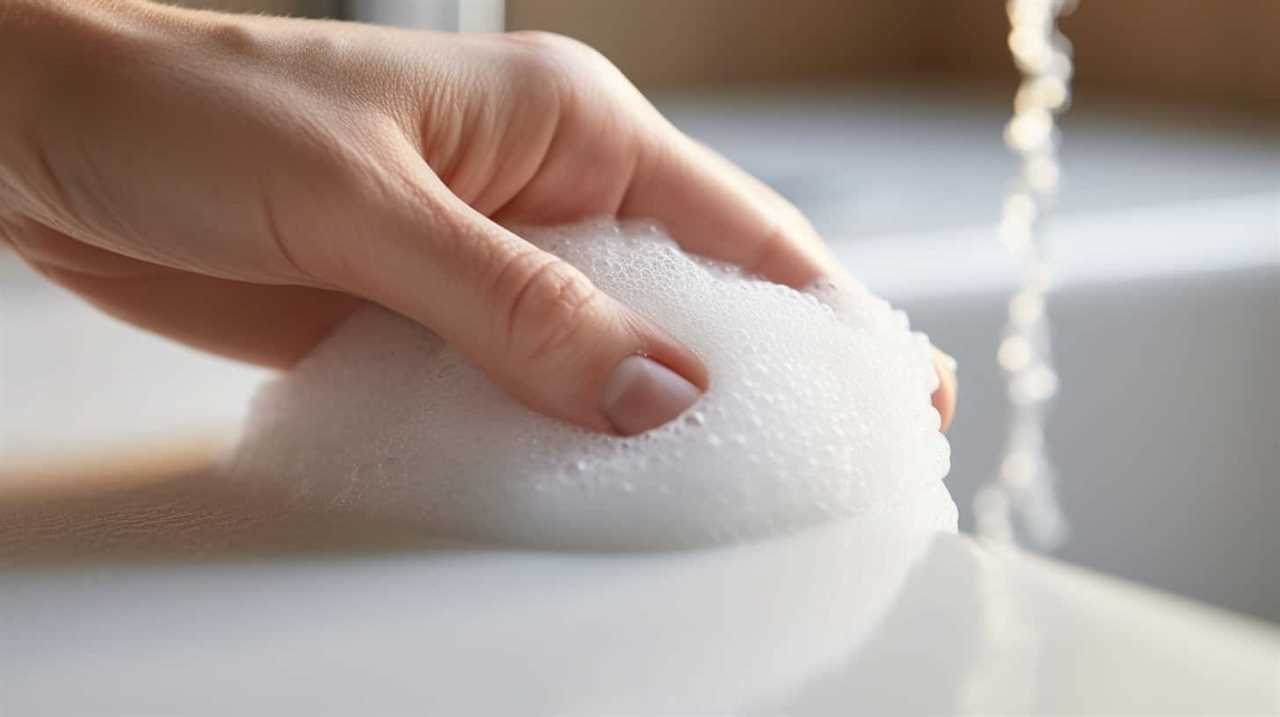
Discover the perfect top flush toilet for your home and elevate your bathroom experience to new heights.
With an impeccable eye for detail and a passion for bathroom-related, Ava leads our editorial team gracefully and precisely.
Under her guidance, Best Modern Toilet has flourished as the go-to resource for modern bathroom enthusiasts. In her free time, you might find Ava exploring antique shops and looking for vintage bathroom fixtures to add to her collection.
-

 FAQ - Advanced Bathroom Queries3 months ago
FAQ - Advanced Bathroom Queries3 months agoWhat Happens if You Sit on the Toilet Too Long
-

 FAQ - Advanced Bathroom Queries3 months ago
FAQ - Advanced Bathroom Queries3 months agoWhy Is My Toilet so Loud When Refilling
-

 Guides3 months ago
Guides3 months agoTroubleshooting Dropping Water Level in Toilet Bowl: Causes and Solutions
-

 Toilet Brands3 months ago
Toilet Brands3 months agoCountries Where You Can’t Flush Toilet Paper
-

 Guides3 months ago
Guides3 months agoChoosing the Right Toilet Flange: A Comprehensive Guide
-

 Guides3 months ago
Guides3 months agoToilet Water Supply Line Sizes: Finding the Right Fit
-

 FAQ - Advanced Bathroom Queries3 months ago
FAQ - Advanced Bathroom Queries3 months agoWhat Happens When You Put Baking Soda in Your Toilet
-

 Guides3 months ago
Guides3 months agoHow to Remove Crystallized Urine From Toilet Bowl



















